2005 Hyundai Azera steering wheel
[x] Cancel search: steering wheelPage 124 of 297
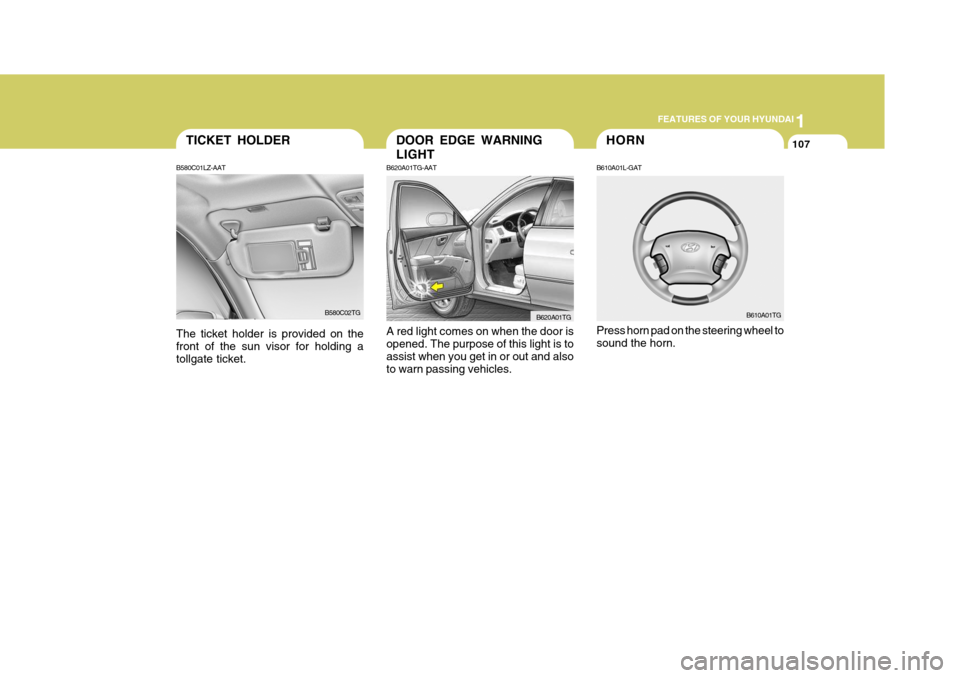
1
FEATURES OF YOUR HYUNDAI
107HORN
B610A01L-GAT Press horn pad on the steering wheel to sound the horn. B610A01TG
B620A01TG-AAT A red light comes on when the door is opened. The purpose of this light is toassist when you get in or out and also to warn passing vehicles. B620A01TG
DOOR EDGE WARNING LIGHT
TICKET HOLDER
B580C01LZ-AAT The ticket holder is provided on the front of the sun visor for holding a tollgate ticket. B580C02TG
Page 125 of 297
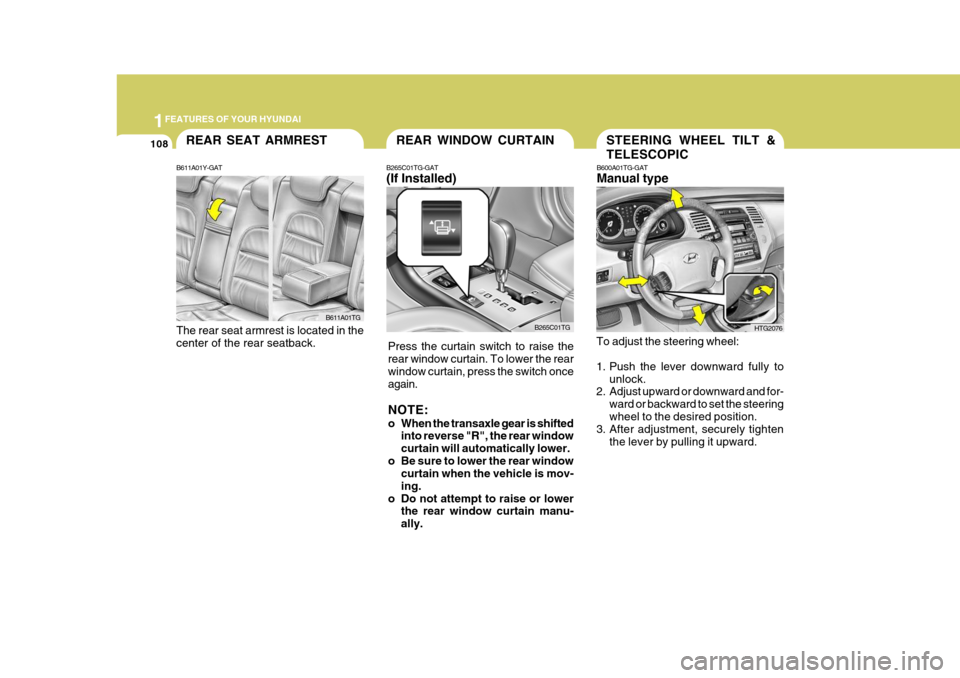
1FEATURES OF YOUR HYUNDAI
108
B611A01Y-GAT
B611A01TG
REAR SEAT ARMREST
The rear seat armrest is located in the center of the rear seatback.
STEERING WHEEL TILT & TELESCOPIC
B600A01TG-GAT Manual type
To adjust the steering wheel:
1. Push the lever downward fully to
unlock.
2. Adjust upward or downward and for-
ward or backward to set the steering wheel to the desired position.
3. After adjustment, securely tighten
the lever by pulling it upward.
HTG2076
REAR WINDOW CURTAIN
B265C01TG
B265C01TG-GAT (If Installed)
Press the curtain switch to raise the rear window curtain. To lower the rearwindow curtain, press the switch once again. NOTE:
o When the transaxle gear is shifted into reverse "R", the rear window curtain will automatically lower.
o Be sure to lower the rear window curtain when the vehicle is mov-ing.
o Do not attempt to raise or lower the rear window curtain manu-ally.
Page 126 of 297

1
FEATURES OF YOUR HYUNDAI
109CRUISE CONTROL
B660A01S-GAT (If Installed) The cruise control system provides automatic speed control for your com-fort when driving on freeways, toll roads, or other noncongested highways. This system is designed to function aboveapproximately 40 km/h (25 mph).
B660B01NF-GAT To Set the Cruise Speed
1. Push the cruise control ON/OFF switch. The "CRUISE" indicator light in the instrument cluster will illumi- nate. This turns the system on.
2. Accelerate to desired cruising speed above 40 km/h (25 mph). B660B01TG
!
B600B01TG-GAT Electric type (If Installed)
B600B01TG
To adjust the desired position of the steering wheel, operate the adjusting switch on the left side of the steeringwheel.
WARNING:
Do not attempt to adjust the steeringwheel while driving as this may re- sult in loss of control of the vehicle and serious injury or death.
!
! CAUTION:
After adjusting the steering wheel, try moving it up and down to make sure it is locked in position.
WARNING:
Do not attempt to adjust the steeringwheel while driving as this may re-sult in loss of control of the vehicle and serious injury or death.
Page 129 of 297

1FEATURES OF YOUR HYUNDAI
112
2. TAPE mode
o Pressing the SEEK ( ) will play thebeginning of the next music seg- ment.
o Pressing the SEEK ( ) will start
replay at the beginning of the musicjust listened to.
3. CD (Compact Disc)/CDC (Compact Disc Changer) mode
o Press the SEEK ( ) once to skip forward to the beginning of the next track.
o Press the SEEK ( ) once to skip back to the beginning of the track.
MUTE Switch
o Press the MUTE switch to disap- pear the sound.
o Press the MUTE switch again to
reproduce the sound.
VOL ( / ) Switch
o Press the VOL ( ) switch to in- crease volume.
o Press the VOL ( ) switch to de-
cease volume.
RADIO (FM1 � FM2 �AM) � TAPE � CD � CDC
SEEK ( / ) Switch Press the SEEK switch 1 sec. or more.
1. RADIO mode When the SEEK ( ) is pressed, the unit will automatically tune to the next higher frequency and when the SEEK ( ) switch is pressed, it will automati-cally tune to the next lower frequency.
�
NOTE: Do not operate audio remote con- trol switches simultaneously. MODE Switch Press the MODE switch to select Ra- dio, Tape, CD (Compact Disc) andCDC (Compact Disc Changer). Each press of the switch changes the display as follows:
AUDIO REMOTE CONTROL SWITCH
B610A01L-GAT (If Installed) The steering wheel audio remote con- trol switch is installed to promote safe driving. B610A02TG
Without Cruise Control System
B610A03TG
With Cruise Control System
Page 188 of 297
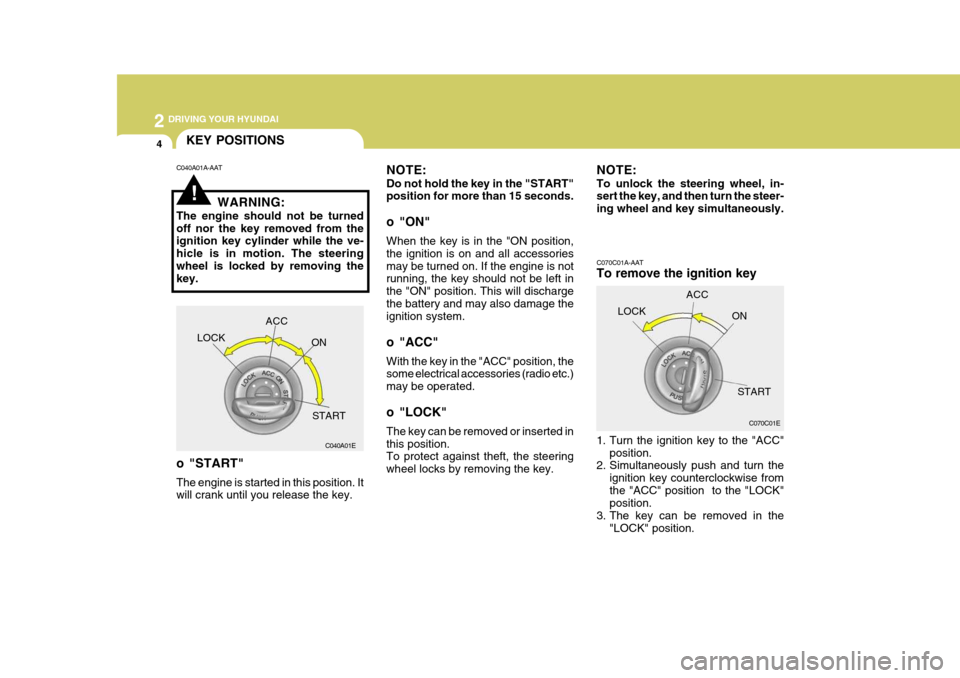
2 DRIVING YOUR HYUNDAI
4
!
KEY POSITIONS
C070C01A-AAT To remove the ignition key
1. Turn the ignition key to the "ACC"position.
2. Simultaneously push and turn the
ignition key counterclockwise from the "ACC" position to the "LOCK" position.
3. The key can be removed in the
"LOCK" position.
NOTE: Do not hold the key in the "START" position for more than 15 seconds.
o "ON" When the key is in the "ON position, the ignition is on and all accessoriesmay be turned on. If the engine is not running, the key should not be left in the "ON" position. This will dischargethe battery and may also damage the ignition system.
o "ACC" With the key in the "ACC" position, the some electrical accessories (radio etc.) may be operated.
o "LOCK" The key can be removed or inserted in this position. To protect against theft, the steering wheel locks by removing the key.
C040A01A-AAT
WARNING:
The engine should not be turnedoff nor the key removed from the ignition key cylinder while the ve- hicle is in motion. The steeringwheel is locked by removing the key.
o "START" The engine is started in this position. It will crank until you release the key. NOTE: To unlock the steering wheel, in- sert the key, and then turn the steer- ing wheel and key simultaneously.
LOCK ACC
ON
START C070C01E
C040A01E LOCK
ACC
ON
START
Page 194 of 297
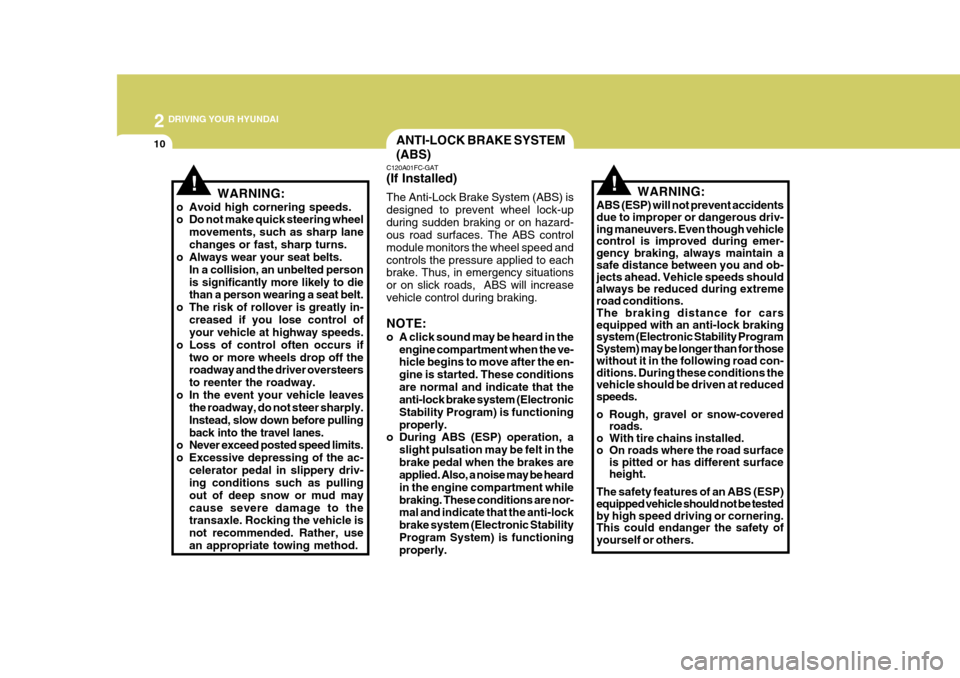
2 DRIVING YOUR HYUNDAI
10
!!
ANTI-LOCK BRAKE SYSTEM (ABS)
C120A01FC-GAT (If Installed) The Anti-Lock Brake System (ABS) is designed to prevent wheel lock-upduring sudden braking or on hazard- ous road surfaces. The ABS control module monitors the wheel speed andcontrols the pressure applied to each brake. Thus, in emergency situations or on slick roads, ABS will increasevehicle control during braking. NOTE:
o A click sound may be heard in the
engine compartment when the ve- hicle begins to move after the en- gine is started. These conditionsare normal and indicate that the anti-lock brake system (Electronic Stability Program) is functioningproperly.
o During ABS (ESP) operation, a
slight pulsation may be felt in thebrake pedal when the brakes are applied. Also, a noise may be heard in the engine compartment whilebraking. These conditions are nor- mal and indicate that the anti-lock brake system (Electronic StabilityProgram System) is functioning properly. WARNING:
ABS (ESP) will not prevent accidents due to improper or dangerous driv-ing maneuvers. Even though vehicle control is improved during emer- gency braking, always maintain a safe distance between you and ob- jects ahead. Vehicle speeds should always be reduced during extreme road conditions. The braking distance for cars equipped with an anti-lock braking system (Electronic Stability Program System) may be longer than for those without it in the following road con- ditions. During these conditions the vehicle should be driven at reduced speeds.
o Rough, gravel or snow-covered roads.
o With tire chains installed.
o On roads where the road surface is pitted or has different surfaceheight.
The safety features of an ABS (ESP)equipped vehicle should not be tested by high speed driving or cornering. This could endanger the safety of yourself or others.
WARNING:
o Avoid high cornering speeds.
o Do not make quick steering wheel movements, such as sharp lane changes or fast, sharp turns.
o Always wear your seat belts.
In a collision, an unbelted personis significantly more likely to die than a person wearing a seat belt.
o The risk of rollover is greatly in-
creased if you lose control ofyour vehicle at highway speeds.
o Loss of control often occurs if
two or more wheels drop off theroadway and the driver oversteers to reenter the roadway.
o In the event your vehicle leaves the roadway, do not steer sharply.Instead, slow down before pullingback into the travel lanes.
o Never exceed posted speed limits.
o Excessive depressing of the ac-
celerator pedal in slippery driv- ing conditions such as pulling out of deep snow or mud maycause severe damage to the transaxle. Rocking the vehicle is not recommended. Rather, usean appropriate towing method.
Page 195 of 297
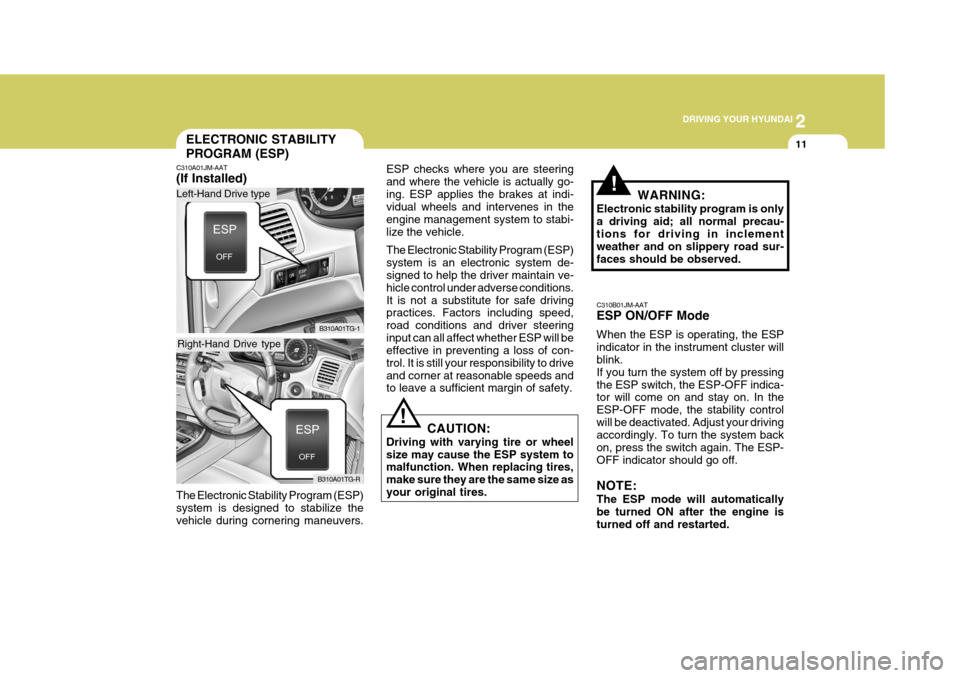
2
DRIVING YOUR HYUNDAI
11
!
CAUTION:
Driving with varying tire or wheel size may cause the ESP system to malfunction. When replacing tires, make sure they are the same size asyour original tires. WARNING:
Electronic stability program is onlya driving aid; all normal precau- tions for driving in inclement weather and on slippery road sur-faces should be observed.!
ELECTRONIC STABILITY PROGRAM (ESP)
C310A01JM-AAT (If Installed) ESP checks where you are steering and where the vehicle is actually go-ing. ESP applies the brakes at indi- vidual wheels and intervenes in the engine management system to stabi-lize the vehicle. The Electronic Stability Program (ESP) system is an electronic system de- signed to help the driver maintain ve- hicle control under adverse conditions.It is not a substitute for safe driving practices. Factors including speed, road conditions and driver steeringinput can all affect whether ESP will be effective in preventing a loss of con- trol. It is still your responsibility to driveand corner at reasonable speeds and to leave a sufficient margin of safety.
B310A01TG-1
C310B01JM-AAT ESP ON/OFF Mode When the ESP is operating, the ESP indicator in the instrument cluster will blink. If you turn the system off by pressingthe ESP switch, the ESP-OFF indica- tor will come on and stay on. In the ESP-OFF mode, the stability controlwill be deactivated. Adjust your driving accordingly. To turn the system back on, press the switch again. The ESP-OFF indicator should go off. NOTE: The ESP mode will automatically be turned ON after the engine is turned off and restarted.
The Electronic Stability Program (ESP) system is designed to stabilize thevehicle during cornering maneuvers.
B310A01TG-R
Left-Hand Drive type
Right-Hand Drive type
Page 202 of 297

2 DRIVING YOUR HYUNDAI
18
C160I01A-AAT Don't Let Your Parking Brake Freeze Under some conditions your parking brake can freeze in the engaged posi-tion. This is most likely to happen when there is an accumulation of snow or ice around or near the rear brakes orif the brakes are wet. If there is a risk the parking brake may freeze, apply it only temporarily while you put the gearselector lever in "P" (automatic) or in first or reverse gear (manual transaxle) and block the rear wheels so the carcannot roll. Then release the parking brake. C160J01A-AAT Don't Let Ice and Snow Accumu- late Underneath Under some conditions, snow and ice can build up under the fenders andinterfere with the steering. When driv- ing in severe winter conditions where this may happen, you should periodi-cally check underneath the car to be sure the movement of the front wheels and the steering components is notobstructed. C160K01A-AAT Carry Emergency Equipment Depending on the severity of the weather where you drive your car, you should carry appropriate emergency equipment. Some of the items youmay want to carry include tire chains, tow straps or chains, flashlight, emer- gency flares, sand, a shovel, jumpercables, a window scraper, gloves, ground cloth, coveralls, a blanket, etc.HIGHER SPEED MOTORING
C170A01A-AAT Pre-Trip Inspections 1. Tires: Adjust the tire inflation pressures tospecification. Low tire inflation pres- sures will result in overheating and possible failure of the tires.Avoid using worn or damaged tires which may result in reduced traction or tire failure. NOTE: Never exceed the maximum tire in- flation pressure shown on the tires. 2. Fuel, engine coolant and engine oil: High speed travel consumes more fuelthan urban motoring. Do not forget to check both engine coolant and engine oil. 3. Drive belt: A loose or damaged drive belt mayresult in overheating of the engine.